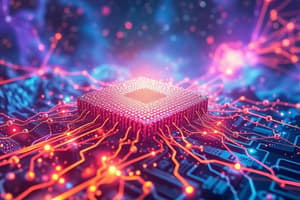Podcast
Questions and Answers
What are the theoretical properties of quantum silicone expected to enhance?
What are the theoretical properties of quantum silicone expected to enhance?
- Electrical resistance
- Magnetic properties
- Electron mobility (correct)
- Thermal conductivity
Which of the following applications could potentially benefit from quantum silicone?
Which of the following applications could potentially benefit from quantum silicone?
- Traditional battery technology
- Thermal insulation
- Conventional light bulbs
- High-speed electronics (correct)
What major challenge impedes the creation of quantum silicone?
What major challenge impedes the creation of quantum silicone?
- Understanding quantum gravity
- Material synthesis and characterization (correct)
- Abundant supply of conventional silicone
- High costs of classical electronic components
How does quantum silicone differ fundamentally from conventional silicone?
How does quantum silicone differ fundamentally from conventional silicone?
Which phenomenon could allow electrons in quantum silicone to transfer signals more efficiently?
Which phenomenon could allow electrons in quantum silicone to transfer signals more efficiently?
Flashcards
Quantum Silicone
Quantum Silicone
Hypothetical material made of silicon with unique quantum properties, unlike typical silicon.
Enhanced Electron Mobility
Enhanced Electron Mobility
Electrons moving faster and more efficiently in a material due to quantum effects.
Quantum Tunneling
Quantum Tunneling
Electrons passing through energy barriers, improving signal transfer.
Quantum Computing
Quantum Computing
Signup and view all the flashcards
Material Synthesis Challenge
Material Synthesis Challenge
Signup and view all the flashcards
Study Notes
Introduction to Quantum Silicone
- Quantum silicone is a theoretical material, not yet synthesized.
- It refers to silicone (a common material in electronics) with quantum properties.
- The quantum properties would be due to the arrangement and behavior of electrons at the atomic level.
- This arrangement could potentially result in novel and improved electronic properties compared to conventional silicon.
Potential Properties of Quantum Silicone
- Enhanced electron mobility: Quantum effects could lead to electrons moving faster and more efficiently within the material.
- Tunneling effects: Electrons might be able to tunnel through energy barriers, allowing for more efficient transfer of electrical signals.
- Unique optical properties: Quantum confinement of electrons could alter the way the material interacts with light, potentially leading to novel light-emitting or light-absorbing capabilities.
- Quantum interference effects: Subtle interactions at the quantum level could lead to the superposition of states, a potential use in quantum computing.
Potential Applications of Quantum Silicone
- High-speed electronics: The enhanced electron mobility could lead to faster transistors and integrated circuits.
- Quantum computing: The quantum mechanical properties offer potential uses in quantum computing, potentially leading to new algorithms and operations.
- Novel sensors: Unique optical properties could be utilized in light-based sensors, which could have applications in a wide range of industries.
Challenges in Creating Quantum Silicone
- Theoretical understanding: A full theoretical understanding of how to design and synthesize quantum silicone is lacking.
- Material synthesis: Producing a material with precise control over the quantum arrangement of atoms within a macroscopic construction would be extremely difficult.
- Characterization: Developing accurate techniques to characterize the quantum state of the material and predict behavior would be necessary.
- Scalability: Expanding the material's creation from microscopic samples to larger, industrially applicable forms remains a challenge.
Comparison to Conventional Silicone
- Conventional silicone (e.g., polydimethylsiloxane) is a classical material, with no consideration required for quantum effects.
- Quantum silicone aims to exploit quantum effects not present in its classical counterpart.
- This difference could lead to distinct properties and applications.
Future Research Directions
- Theoretical modeling and simulations are crucial to understand quantum features at the atomic level.
- Experimental research is needed to synthesize and test the material's properties.
- Development of new synthesis techniques and characterization methods are necessary.
- Exploring potential applications and use cases of such a material is important.
Studying That Suits You
Use AI to generate personalized quizzes and flashcards to suit your learning preferences.
Description
Explore the theoretical material known as quantum silicone, which possesses unique quantum properties that could transform electronic applications. Discover its potential characteristics such as enhanced electron mobility, tunneling effects, and unique optical properties, presenting new opportunities for electronics innovation.




